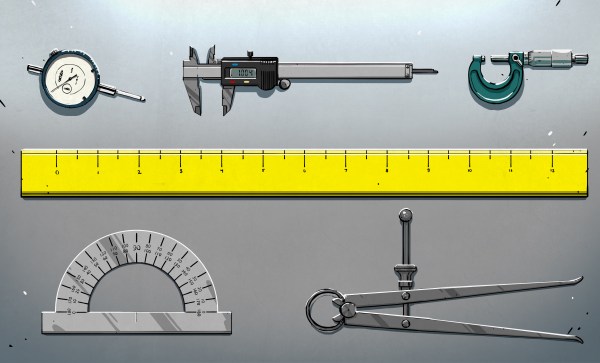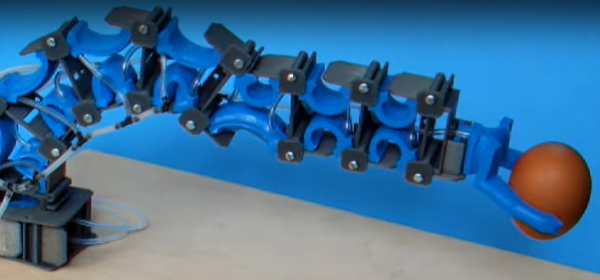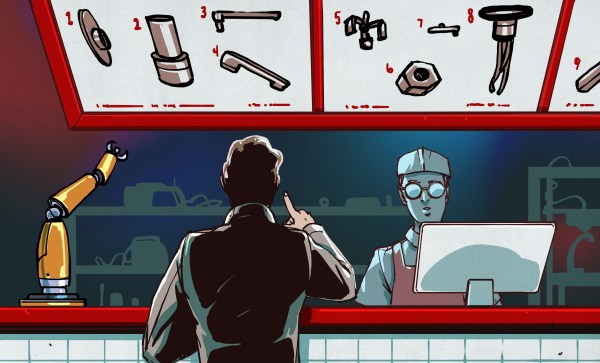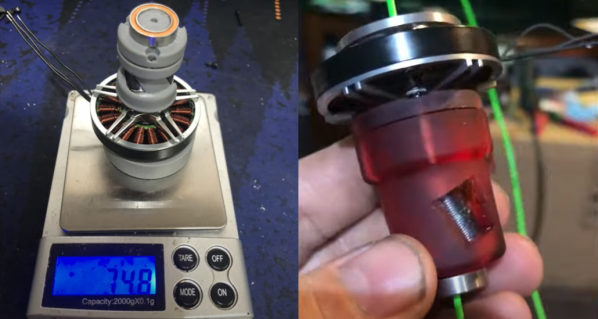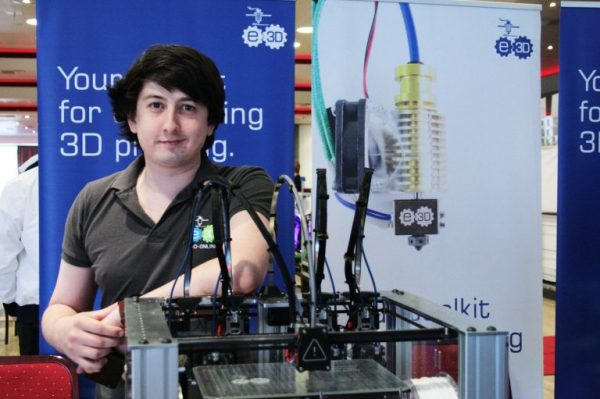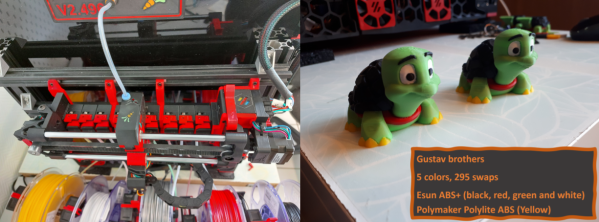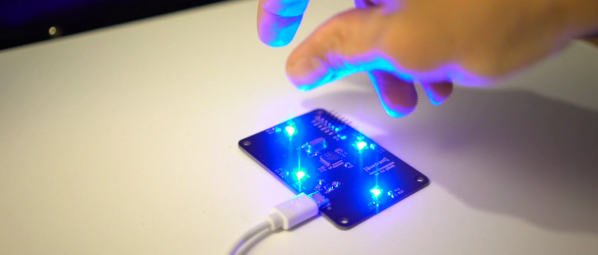The story of precision, as told by Simon Winchester, is captured in The Perfectionists: How Precision Engineers Created the Modern World. Published in 2018, Winchester’s overview stretches as far back to the Antikythera mechanism and brings us to present day silicon wafer manufacturing. Of course, this isn’t a chronology of all-things made precisely. Instead, it’s a romp through engineering highlights that hallmark either a certain level of precision manufacturing or a particular way of thinking with repercussions for the future. Continue reading “Books You Should Read: The Perfectionists”
Author: Sonya Vasquez179 Articles
Squishy Robot Hardware Does Well Under Pressure
If your jealousy for Festo robots is festering, fret not! [mikey77] has shown us that, even without giant piggy banks, we can still construct some fantastic soft robotics projects with a 3D printer and a visit to the hardware store. To get started, simply step through the process with this 3D Printed Artificial Muscles: Erector Set project on Instructables.
In a nutshell, [mikey77] generously offers us a system for designing soft robots built around a base joint mechanism: the Omega Muscle. Fashioned after its namesake, this base unit contains an inflatable membrane that expands with pressure and works in tandem with another Omega Muscle to produce upward and downward angular movement. Each muscle also contains two endpoints to connect to a base, a gripper, or more Omega Muscles. Simply scale them as needed and stack them to produce a custom soft robot limb, or use the existing STLs to make an articulated soft gripper.
This project actually comes in two parts for robot brawns and brains. Not only does [mikey77] take us through the process for making Omega muscles, we also get a guide for building the pressure system designed to control them. Taken together, it’s a feature-complete setup for exploring your own soft robotics projects with a great starting project. Stay tuned after the break for a demo video in action. There’s no audio, but we’re sure you’ll be letting off an audible pssssh in satisfaction to follow along.
It’s not every day that we see FFF-based 3D printers making parts that need to be airtight. And [mikey77’s] success has us optimistic for seeing more air muscles in future projects down the road. In the meantime, have a look at the silicone-silicon half-breeds that we’ve previously caught pumping iron.
Continue reading “Squishy Robot Hardware Does Well Under Pressure”
Made To Spec: The Coming Age Of Prototyping As A Service
In the last decade, the price for making a single PCB plummeted. And we’ve featured tons of hacks with boards hailing from places like OSH Park or Seeed Studio. But this phenomenon isn’t isolated, and all sorts of one-off prototyping services are becoming cheaper and looking to satiate both hobbyist and engineer alike.
Today, I want to blow the lid off a few places offering one-off mechanical prototyping services. I’ll take us through some history of how we got here, introduce a few new players, and finally highlight some important tradeoffs before you start ordering bespoke aluminum parts straight to your doorstep.
Now go get your ANSI Z87+ safety glasses, and let’s get started.
Continue reading “Made To Spec: The Coming Age Of Prototyping As A Service”
Rolling-Screw Extruder Goes Brushless
In the name of saving weight and pushing plastic, it’s nice to see continuous tweaks on 3D printer extruders from folks in their spare time. And to go where no extruder has gone before, [wayne dalton] has managed to combine the rolling screw thread extruder concept directly onto a brushless pancake motor. The result is a filament pushing mechanism weighing in at just under 90 grams. What’s more, this modification arrives a few weeks weeks after we first saw an open source version of the rolling screw thread extruder land on Thingiverse back in September.
Getting a direct-drive BLDC extruder off the ground comes with a number of geometry challenges. First, filament needs to be fed through a motor with a hollow shaft. Since this motor will be operated under closed loop control via an ODrive, the motor also requires an encoder with a hole down the middle too. [wayne dalton] patiently walks us through all the changes made over seven iterations to produce a setup that will eventually mount onto a machine and start printing. But for that last step we’ll need to check back a bit later. Finally, this progress comes with the promise of a possible open source release of the design files, so we’re pretty eager to stay tuned for future videos.
In the last few years, we’ve seen state-of-the-art extruders move away from NEMA 17 motors in favor of more compact solutions like planetary gears and even lasers to push printers faster. We’re excited to see that folks keep trying to set the bar higher.
Remembering Sanjay Mortimer, Pioneer And Visionary In 3D Printing
Over the weekend, Sanjay Mortimer passed away. This is a tremendous blow to the many people who he touched directly and indirectly throughout his life. We will remember Sanjay as pioneer, hacker, and beloved spokesperson for the 3D printing community.
If you’ve dabbled in 3D printing, you might recall Sanjay as the charismatic director and co-founder of the extrusion company E3D. He was always brimming with enthusiasm to showcase something that he and his company had been developing to push 3D printing further and further. But he was also thoughtful and a friend to many in the community.
Let’s talk about some of his footprints.
Continue reading “Remembering Sanjay Mortimer, Pioneer And Visionary In 3D Printing”
Enraged Rabbit Project Is A Filament Cocktail Special
As long as 3D printers have been around, it seems as though many of us have dreamed about nozzle-sharing solutions for multicolor 3D prints. Just because Prusa’s MMU has had the spotlight for some time doesn’t mean that there’s no space to design something original. If you’re craving something new to feast your eyes upon, look no further than the EnragedRabbitProject by [EtteGit]. Built for Voron 3D printers, it’s a scalable filament changing solution designed from the ground up that expands to accommodate up to 9 filaments.
EnragedRabbitProject is broken into four main components. First comes the Enraged Rabbit Carrot Feeder (ERCF), the system that handles filament selection, retraction, and loading. Next, comes the Carrot Patch (ERCP), a spool holder/buffer combo that’s needed per spool. For those unfamiliar with filament changers, unspooling filament is easy, but rewinding it back onto the spool is hard. And since the nozzle will retract a significant length of filament when it switches between filaments, it’s important to manage all this extra loose filament to prevent tangles. A filament buffer is the solution; it’s a clever mechanical addition to the spool holder that will manage the extra filament that gets unwound during these filament changes. Beyond these two systems is the King’s Seat (ERKS) a Voron-2 setup that purges extra filament into beads instead of purge blocks, and finally, the filament sensor, which detects filament presence for filament changes.
It’s sometimes hard to appreciate the reliability of these sorts of CNC systems. On that note, keep in mind that the prints on the project’s landing page are the results of hundreds if not thousands of filament swaps — truly an astonishing feat. Beyond reliability is the project’s presentation. [EtteGit] has kindly posted STEP and STL files for all mechanical components, the Klipper configuration files, and a bill-of-materials that will scale according to the number of filaments you’re installing.
We’re thrilled to see folks continue to innovate on the concept of what it means to be a multi-color or multi-material 3D printer. For other takes on multi-filament setups, have a look at [Paul Paukstelis’] microscope-inspired head changer, and [MihaiDesigns’] removable tool head concept.
Continue reading “Enraged Rabbit Project Is A Filament Cocktail Special”
Laser Theremin Turns Your Hand Swooshes Into Music
In a world where smartphones have commoditized precision MEMS Sensors, the stage is set to reimagine clusters of these sensors as something totally different. That’s exactly what [chronopoulos] did, taking four proximity sensors and turning them into a custom gesture input sensor for sound generation. The result is Quadrant, a repurposable human-interface device that proves to be well-posed at detecting hand gestures and turning them into music.
At its core, Quadrant is a human interface device built around an STM32F0 and four VL6180X time-of-flight proximity sensors. The idea is to stream the measured distance data over as fast as possible from the device side and then transform it into musical interactions on the PC side. Computing distance takes some time, though, so [chronopoulos] does a pipelined read of the array to stream the data into the PC over USB at a respectable 30 Hz.
With the data collected on the PC side, there’s a spread of interactions that are possible. Want a laser harp? No problem, as [chronopoulos] shows how you can “pluck” the virtual strings. How about an orientation sensor? Simply spread your hand over the array and change the angle. Finally, four sensors will also let you detect sweeping gestures that pass over the array, like the swoosh of your hand from one side to the other. To get a sense of these interactions, jump to the video demos at the 2:15 mark after the break.
If you’re curious to dig into the project’s inner workings, [chronopoulos] has kindly put the firmware, schematics, and layout files on Github with a generous MIT License. He’s even released a companion paper [PDF] that details the math behind detecting these gestures. And finally, if you just want to cut to the chase and make music of your own, you can actually snag this one on Tindie too.
MEMs sensors are living a great second life outside our phones these days, and this project is another testament to the richness they offer for new project ideas. For more MEMs-sensor-based projects, have a look at this self-balancing robot and magic wand.
Continue reading “Laser Theremin Turns Your Hand Swooshes Into Music”

